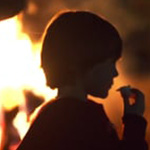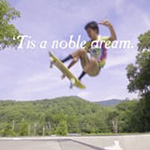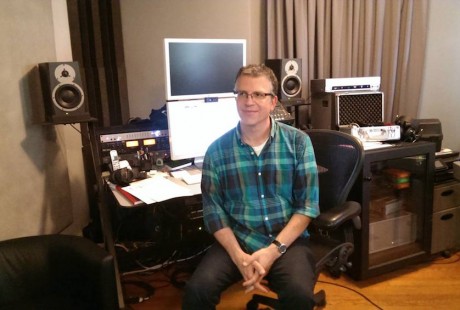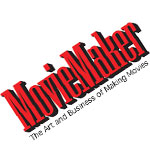video post production | 2BruceStudio - Part 2
One Essential Element: From Powwow to Post Production in Asheville (Part One in a Series)
On 01, Feb 2016 | In 2BruceStudio News, Asheville Production, Composing | By Bruce Sales
Toward the end of last summer Jack Becker and Matt Levin, creative directors at Element Advertising, opened a large orange door looking for help. It’s a double-sized door the color of a fruit from Florida. While walking a few blocks to 2BruceStudio, what willpower it must have taken – bypassing coffee and pastries from Malaprop’s Bookstore/Cafe, avoiding delights from The Chocolate Fetish, resisting an urgent text message while crossing the street? Jack and Matt needed help with plans for The Eastern Band of Cherokee Indians package of fifteen videos. Raven’s Eye Productions would shoot and edit the videos. 2BruceStudio would supply post production services and one element missing from each of the videos – sound.
Jack Becker’s history of award winning work with 2BruceStudio began in 2007. The fun often begins with a pow-wow about the message. Jack and Matt already had a creative direction for music and sound design, but they were eager to hear my ideas. We agreed to music and sound ideas for each video so quickly, we were still fresh enough to rough out a timetable and budget. Element approved my post production budget within two weeks. It was the last good luck sign we needed before the Visit Cherokee project kickoff.
Before the first video arrived I had a good chance to learn more about Cherokee history, culture and music. The Cherokee people remain, after their first contact with European settlers in the 16th century, one of the most socially and culturally advanced of all Native American tribes. Sequoyah’s invention of the Cherokee syllabary in 1821 made it possible to read and write in the Cherokee language. The Cherokee published newspapers and built over one hundred schools while neighboring settlers, for the most part, eked out an illiterate existence. The Eastern Band of Cherokee are mainly descendants of 800 non-participants in the troubled Trail of Tears to Indian Territory (now Oklahoma). Read “Jacksonland: President Andrew Jackson, Cherokee Chief John Ross, and a Great American Land Grab” by Steve Inskeep for more.
Our first video “Itinerary Builder” instructed site users on using tools in the web site for building a visitor itinerary. After the animation was finished, original music was scored and the ubiquitous voice of Sharon Feingold was recorded and mixed at 2BruceStudio.
 “Greatest Hits”
“Greatest Hits”
 In the first frames of “Skate Park”
In the first frames of “Skate Park”
From the jingle house to the Miles Building
On 09, Aug 2014 | In 2BruceStudio News, Asheville Production, Composing | By Bruce Sales

SOUND GUY: Bruce Sales sits in his studio space in the Miles Building in downtown Asheville. Photo courtesy of Bruce Sales
You probably won’t find a rock band in Bruce Sales’ 2BruceStudio, but that doesn’t mean he isn’t keeping busy. “My studio is more geared for postproduction,” says Sales. “I work with filmmakers and people doing video. So it’s [creating] the sound for the picture. They need sound design or voice recording or original music, or they just need me to mix it. Or fix it — I’ve been doing a lot of fixing lately.”
After majoring in songwriting at Berklee College of Music in Boston, Sales landed a gig at David Horowitz Music Associates, a commercial “jingle house” in New York City. He spent the next 15 years composing and engineering for big-name clients like Pepsi and GE, as well as small films.
And while the Asheville native says out-of-towners such as HBO and The History Channel still call on him regularly for voice recording work, he’s also made his mark in the local community. Besides producing the Asheville 48 Hour Film Project, Sales sponsors the Asheville Music School’s summer camp program, giving young musicians their first recording experience. The kids, he says, “just kind of walk in and play, and they get their mix. The largest group I had in here was 12 kids: They’re all lined around the walls, and I recorded them all at once playing a couple of songs. In the last 15 minutes, I mixed it together and gave them a version they can give their parents.” He also works with local musicians (including a lot of rappers and hip-hop artists lately, thanks to his knack for high-quality vocal recording), and businesses such as The Biltmore Co. and Travelling Yogini tours.
Asheville #1 Town to Live and Work as a Moviemaker
On 30, Mar 2014 | In 2BruceStudio News, Film | By Bruce Sales
 It’s nice waking up in MovieMaker Magazine’s “#1 Town” for filmmakers to live and work. But I must say, we wake up every day knowing full well it could turn out more like #2, or worse. How stiff was the competition? Where is another town with a population of 100,000 or less earning nicknames like “The Paris of the South”, “The San Francisco of the East”, or “Beer City USA”? MovieMaker Magazine explains:
It’s nice waking up in MovieMaker Magazine’s “#1 Town” for filmmakers to live and work. But I must say, we wake up every day knowing full well it could turn out more like #2, or worse. How stiff was the competition? Where is another town with a population of 100,000 or less earning nicknames like “The Paris of the South”, “The San Francisco of the East”, or “Beer City USA”? MovieMaker Magazine explains:
Voted the most beautiful place in the United States by Good Morning, America, Asheville sets the gold standard for best small town moviemaking. From the Pisgah National Forest to the Blue Ridge Parkway, the Art Deco downtown to the Biltmore Estate, it has a vibrant history with productions like Last of the Mohicans, The Green Mile, The Hunt for Red October, The Hunger Games—and who could ever forget the Dirty Dancing lift scene from Lake Lure?
With nearly a dozen local film festivals (including the Chuck Norris-inspired ActionFest), community support from the Asheville Cinema Society, the Asheville Film Society, Asheville Area Arts Council, Screen Artists Co-op, and Western North Carolina Film Commission, the town is chock full of pre- and post- production facilities and some of the friendliest crew around. “The Hunger Games would not have been possible without all of the support from the local community and WNC Film Commission,” said director Gary Ross.
I was born in Asheville, moved away and came back in 2005. I haven’t seen everything, but driving this evening, as the highway reached a favorite panorama, the sunset over mountain peaks seemed to have everything. And when I walk through the forest here, there’s a hint why Cherokee Indians still hold such deep reverence for Western North Carolina. It’s not an easy living for filmmakers in Asheville, but it can be a good life.

